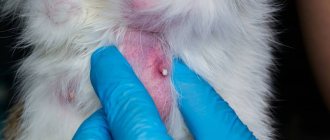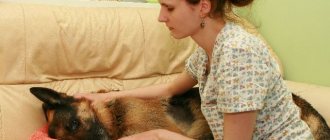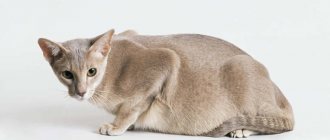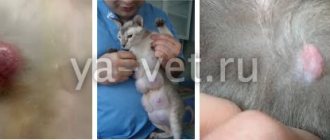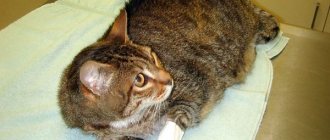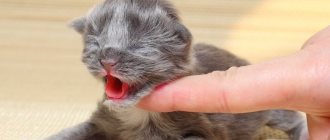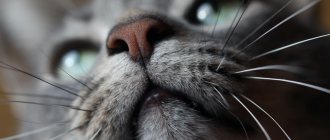The brain is the central organ in all animals. Therefore, the slightest violations in its work can lead to irreparable consequences. One of the most serious pathologies of this organ is stroke. This is an acute circulatory disorder as a result of blockage or rupture of a vessel supplying the brain. Knowing how to recognize this disease and provide first aid, you can save your pet and reduce the risk of developing severe complications.
Features of strokes in cats
Animals suffer from strokes less often than people, but the pathology can also occur in them. The risk increases especially in older pets. Young animals are more likely to develop microstrokes—a milder degree of cerebrovascular accident.
The main difference between microstrokes is the smaller area of damage to brain tissue and the duration of oxygen starvation of nerve cells. This condition is much easier to treat and is less likely to be accompanied by long-term disorders of the nervous system. But don't underestimate the seriousness of this condition. In any case, the animal will need urgent help.
Causes of pathology
The main factors predisposing to the development of stroke include low physical activity, excess weight and an unbalanced diet (excess fat). These factors often provoke the development of diabetes mellitus, the complication of which is often a stroke. Other diseases that can lead to disruption of the blood supply to the brain include:
- parasitic infections and helminthiasis, accompanied by an increase in body temperature;
- hypertension;
- prolonged stress and the disorders of the nervous system provoked by it;
- pathologies of the cardiovascular system (congenital or acquired);
- injuries of the skull and spine;
- oncological diseases;
- acute poisoning with poisons affecting the walls of blood vessels;
- renal failure;
- autoimmune diseases (vasculitis).
Although the causes of a stroke can vary greatly, the symptoms will almost always be the same, as will the principles of helping the animal.
Ischemic encephalopathy
In the medical reference book this is what is called a circulatory disorder in the tissues of the brain.
Although the structure of the vascular system in cats differs from that of humans, failure in its functioning also affects the cat’s future life.
When a pet’s healthy blood vessels continuously supply the brain and the entire body with blood, then the pet frolics carefree, plays, and takes care of itself day after day. A trusting relationship is established between the owner and the murka: friendship and communication grows through play and feeding.
But as soon as a malfunction occurs in any vessel of the head: a capillary ruptures, a plaque or clot appears, the blood flow weakens or stops.
Without continuous blood circulation, brain tissue immediately begins to deteriorate. This process is called feline stroke.
Main symptoms of the disease
The first and earliest manifestation of a stroke is changes in the pupils. The pet's eyes begin to make frequent, involuntary fluctuations, and the pupils of the left and right eyes begin to differ in size. Other symptoms and the degree of their manifestation will depend on the extent of the circulatory disorder. Common symptoms of a stroke include:
- change in behavior (lethargy or unreasonable aggression);
- digestive system disorders (vomiting, constipation, involuntary bowel movements and urination);
- loss of consciousness for up to 2 minutes (fainting);
- gait disturbances, convulsions, paralysis;
- rapid breathing;
- hemorrhages in the eyeballs;
- severe muscle weakness, up to the inability to swallow food.
If one or more of these symptoms appears, you should immediately seek help from a veterinary center. Try to record all the problems that occur in the animal (in writing), this will facilitate the process of making a diagnosis and prescribing the correct treatment.
Manifestations of a microstroke
Such pathologies may not be accompanied by significant symptoms, so they are easy to ignore. Most often, the following symptoms indicate the presence of a microstroke:
- drowsiness, lethargy of the pet;
- vomit;
- headache. The animal meows loudly and pitifully, trying to hide in the quietest place;
- photophobia. The cat tries to hide in the darkest areas of the house;
- sudden changes in blood pressure. The cat suddenly, for no reason, freezes in place in a state of heightened attention.
It is important to pay attention to these violations in time and seek qualified help. Such symptoms can occur with many other pathologies, but only a specialist can make an accurate diagnosis.
Clinical picture
When acute cerebral ischemia occurs, the pet’s condition changes dramatically. The cat becomes inactive, tries to find a secluded place and curl up into a ball. A stroke may be accompanied by trembling of the animal’s limbs, convulsions, depression of consciousness, urinary and fecal incontinence. In advanced cases, paralysis occurs, and the pet cannot move its limbs.
What to pay attention to:
- if a cat has a stroke, the size of the pupil of one eye is different from the other;
- with acute cerebral ischemia, the animal develops blindness;
- During a stroke, the pet often staggers while walking and may lose consciousness.
A sick cat often becomes inactive
Attention! During a stroke, your pet may appear frightened. At the same time, his behavior changes radically. Once “tame” animals begin to avoid contact with the owner, they can hiss and show aggression.
Diagnostics
In most cases, to make an accurate diagnosis, the veterinarian only needs to examine the furry patient and interview his owner. But in order to prescribe the correct treatment, it will be necessary to clarify the type of pathology, the degree of brain damage and a number of other important indicators. For this, additional tests are prescribed:
- laboratory analysis of blood and urine;
- magnetic resonance imaging;
- computed tomography.
These are the most effective diagnostic methods available today. They allow you to accurately identify a stroke and find out which parts of the brain it affected.
How to provide first aid to an animal
The most important thing if you suspect a stroke in a cat is to immediately contact a veterinarian and describe all the symptoms that the animal has experienced. After this, you will need to take him to a specialized veterinary clinic as quickly as possible. But there are situations when you will need to see a veterinarian at home, since the risks when transporting your pet will be too high. In this case, before the doctor arrives, the cat needs to be given first aid. It consists of:
- placing the animal on its side. Any flat and soft surface is suitable for this;
- avoiding contact of the pet with any potentially dangerous objects;
- examining the mouth, if necessary, you will need to clean it of vomit or excess saliva;
- distracting and calming the cat by stroking and quiet conversation.
It is also necessary to get rid of any possible irritants. You need to close the curtains and remove sources of loud sounds or bright lights. It is important to remember that before the veterinarian arrives, it is strictly forbidden to give the animal medications or give injections. Also, do not use cold compresses or other “home” treatment options. Their use can worsen the cat's condition, even lead to death.
Absolutely forbidden!
At home, if ischemia is suspected, the following independent actions are prohibited:
- Do not apply cold compresses to the scalp area! This will only contribute to the spread of the hematoma formed in the brain.
- Do not give any injections without permission or verbal instructions from your veterinarian!
- It is forbidden to give any tablets, especially when the animal is unconscious!
The best thing an owner can do is to take the pet to a veterinary facility as soon as possible!
Drug therapy
Stroke itself cannot be cured, since it is a consequence of other pathologies. Therefore, therapy is aimed at eliminating the factors that provoked it and restoring normal blood circulation in the brain.
First of all, the animal is given infusion therapy (drips) aimed at restoring the body and preventing dehydration. After the cat’s condition has stabilized, symptomatic treatment is prescribed. It allows you to strengthen the walls of blood vessels, improve the functioning of neurons and prevent their further death. For this purpose they prescribe:
- Prednisolone. A hormonal drug that effectively eliminates swelling and inflammation.
- But-shpu. The product eliminates spasms and pain caused by them.
- Glucose. Provides additional nutrition to body cells, primarily neurons.
- Neuromidin. Helps restore impulse transmission between nerve cells.
Depending on the clinical picture, the animal may be prescribed other drugs, for example, diuretics, antibiotics or antiemetics. In case of significant oxygen starvation, oxygenation is carried out. To do this, the animal is put on a breathing mask or placed in a special chamber with a high oxygen content.
Possible complications
The most dangerous complication of acute ischemia is death. In some cases, the animal has to be euthanized, since during a stroke important centers of the brain can be affected. The consequences of the disease are often blindness, deafness and epileptic seizures. After a stroke, a cat may never return to its normal lifestyle due to paralysis of its limbs. One of the complications of a stroke can be pulmonary embolism, that is, a blood clot moves and leads to blockage of other vessels, which can cause respiratory and cardiac arrest.
A pet after a stroke requires a long recovery
Attention! To avoid complications, it is important to follow all doctor’s recommendations and give the necessary medications during the recovery period.
Home care and treatment
It is better for the cat to spend the first few days after a stroke in a hospital. This will allow him to receive maximum medical care, since the animal will be under constant supervision of medical personnel. Once the threat to life has been eliminated, treatment can be continued at home.
During home treatment, you will need to administer drugs in the form of injections. They are:
- subcutaneous Injected using a special syringe into the withers of the animal;
- intramuscular. The injection is given into large muscles;
- intravenous. Most often, droppers are used for intravenous administration.
It is important to consider that to perform injections you must have sufficient knowledge and skills. If they are not available, it is better to entrust the injections to veterinarians. To do this, you will need to bring the animal to the clinic or call a veterinary nurse to your home.
You need to pay attention to the proper nutrition of your pet. If chewing function and the ability to swallow food are preserved, there will be no difficulties. Otherwise, you need to feed through a syringe or IV. Food should be easily digestible in liquid or semi-liquid form. Try to avoid fatty meats; a simple chicken breast is optimal. Vegetables, dairy products, and light broths will also be needed.
To place the animal, you will need to choose the quietest corner with dim lighting. A lying cat needs to be turned over every three hours, this is necessary to prevent bedsores. If the animal tries to get up and walk on its own, do not interfere, but monitor all movements.
To speed up rehabilitation, various additional techniques can be used:
- massage;
- electrophoresis;
- magnetotherapy.
The first improvements will become noticeable 1-2 weeks after the start of the course of physiotherapy. It is important to remember that full recovery after a stroke is a long process and can take from six months to one and a half years.
Cat rehabilitation
The doctor will be able to determine how recovery will proceed after a three-day course of treatment.
When the pet is at home, you will be required to care for it and help. First of all, place it in a warm, clean, comfortable place without drafts. If the cat cannot roll over on its own, you need to turn it over yourself periodically. You may lose control of your bowel movements - you will need to purchase disposable diapers. If there is loss of sensitivity or paralysis of the limbs, massage will be needed. You must not allow your pet to become hypothermic to prevent infection, pneumonia and other diseases from developing.
You may need to syringe feed him.
Cats quickly develop replacement functions: if vision is partially lost, hearing and smell become stronger, and the cat will be able to quickly navigate in space thanks to them.
Usually, after a stroke, if the dynamics are positive, the cat lives as long as normal cats live.
Some functions may not be restored 100%, depending on the severity of the stroke. In some cases, lifelong medication support is necessary.
All that is required of you is patience, support for your pet: love and care will help you recover faster, and unquestioning conscientious fulfillment of the veterinarian’s requirements. We are responsible for those we have tamed. When symptoms are quickly identified and treatment is started on time, then improvement occurs faster.
Consequences of a stroke
The most serious complication of a stroke is the death of a pet. Other severe and practically irreparable consequences include:
- Complete or partial paralysis. It is difficult to treat and persists throughout life in most animals.
- Pneumonia. Occurs as a result of inhalation of vomit or prolonged lying down. With proper care and treatment, it does not occur at all or heals quickly enough.
- Visual and hearing impairments. In most cases they are reversible.
Some complications can be treated, but there are often situations where they remain with the animal for life. But with proper and timely treatment, the likelihood of irreversible consequences will be much less.
Life expectancy and relapses
The prognosis for ischemic stroke is most favorable. Hemorrhagic forms are severe and often result in the death or severe disability of the cat. The sooner qualified assistance was provided, the better the prognosis; this is one of the main factors in the full restoration of brain function after a stroke.
As a rule, relapses occur in the absence of treatment for the underlying disease that caused the stroke. Therefore, strict adherence to medical recommendations will reduce their likelihood to a minimum.
Reference
A stroke is a condition in which the blood supply to the brain is disrupted, causing brain cells to die. As a result, numerous body functions are disrupted, including respiratory, visual, etc.
A stroke occurs in one of two forms:
- hemorrhagic: when a blood vessel bursts in the brain, hemorrhage occurs;
- ischemic: the vessel becomes clogged and becomes an obstacle to adequate blood supply to neurons.
Cats are also prone to micro-stroke. The symptoms are exactly the same as in humans and disappear within a few days. The cat feels a severe headache, partial numbness in the face and paws, becomes too sensitive to light and noise, and coordination of movements is slightly impaired. A microstroke is essentially the same as a stroke, but only affects small vessels, so its consequences are not critical, and the recovery period is relatively quick.
A stroke can be widespread (many areas of the brain are affected) or local (neurons die in only one area). With a major stroke, such a global part of the brain can be affected that the animal quickly dies.
The well-being, severity of the condition, and the speed of rehabilitation of your pet directly depend on which part of the brain is damaged and how badly.
Neutered cats are at particular risk most are overweight and inactive. That is why you need to feed them only with special food and strictly observe the daily caloric intake.
Sometimes a stroke occurs due to anesthesia. As you know, cats have a hard time with it, so they are given local anesthesia.
How to prevent a stroke
There is no specific prevention of this pathology, but steps can be taken to reduce the likelihood of developing a stroke. The most effective include:
- Careful monitoring of body weight. Even if the norm is slightly exceeded, it is necessary to adjust the diet and stimulate the pet’s physical activity;
- balanced diet. It should consist of at least half protein, try to avoid excess fat;
- Monitor blood pressure, especially in older animals. For this, a special tonometer is used;
- Avoid exposing your pet to severe stress;
- secure the space available to the cat. It is necessary to store hazardous substances in places inaccessible to the animal; a good solution would be to install a special mesh on the window to prevent it from falling;
- Make sure your pet gets enough fresh air and physical activity.
Stroke is an extremely serious pathology, the development of which is much easier and cheaper to prevent than to treat. Therefore, try to pay maximum attention to prevention, this will reduce the likelihood of developing a stroke and its severe complications.


